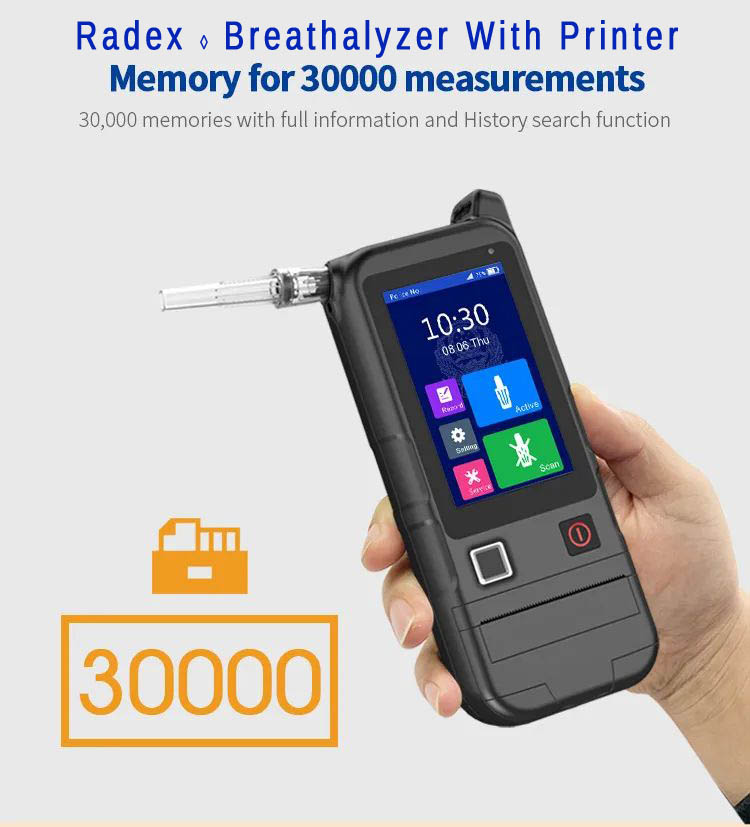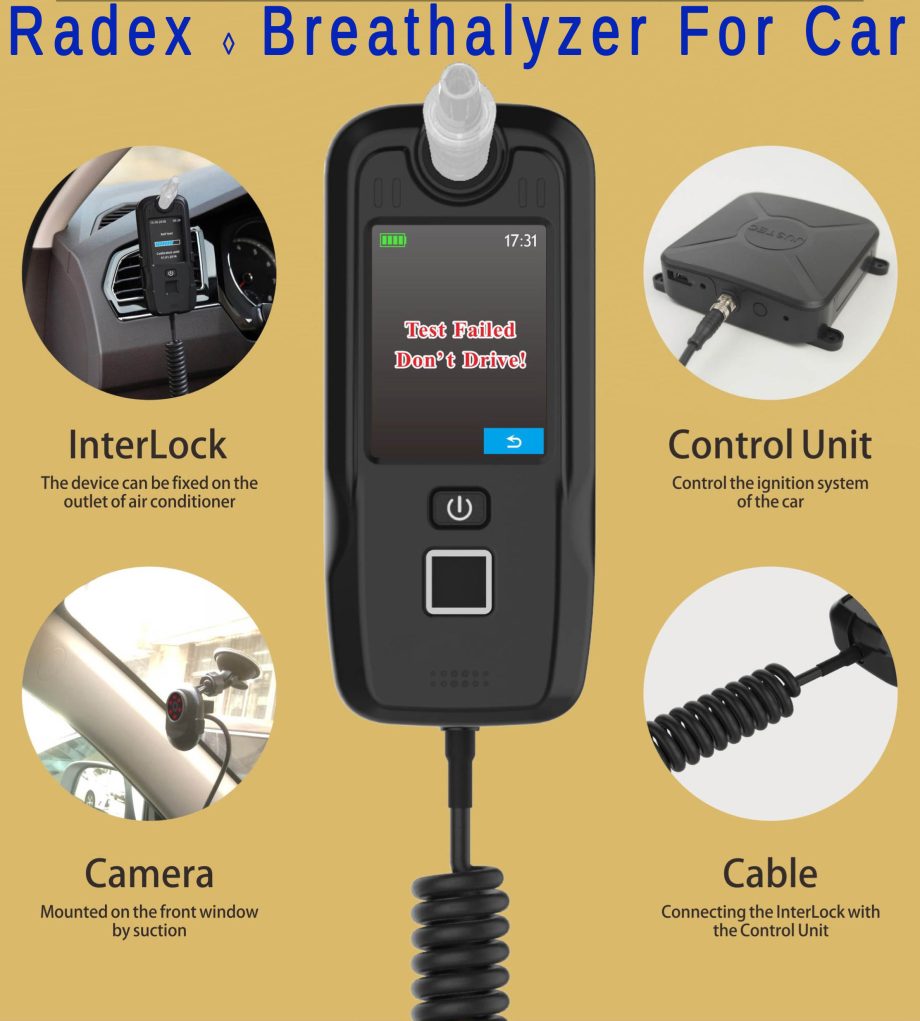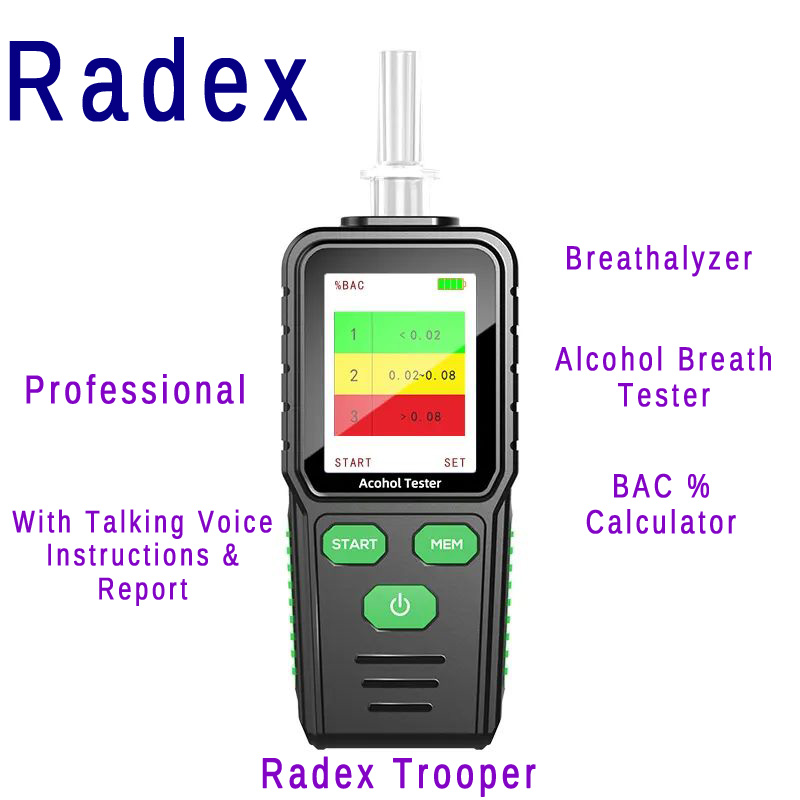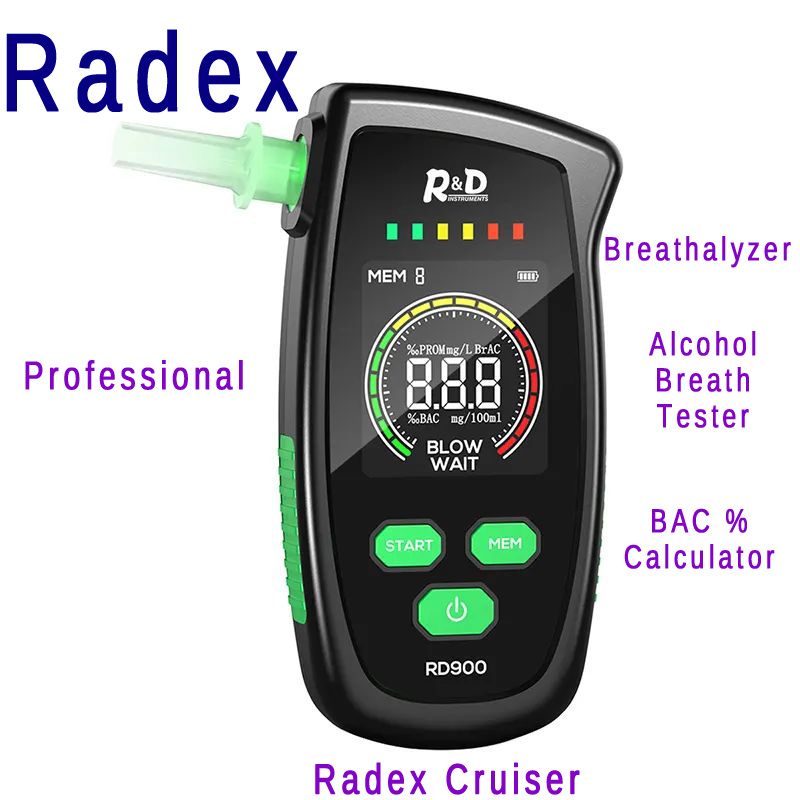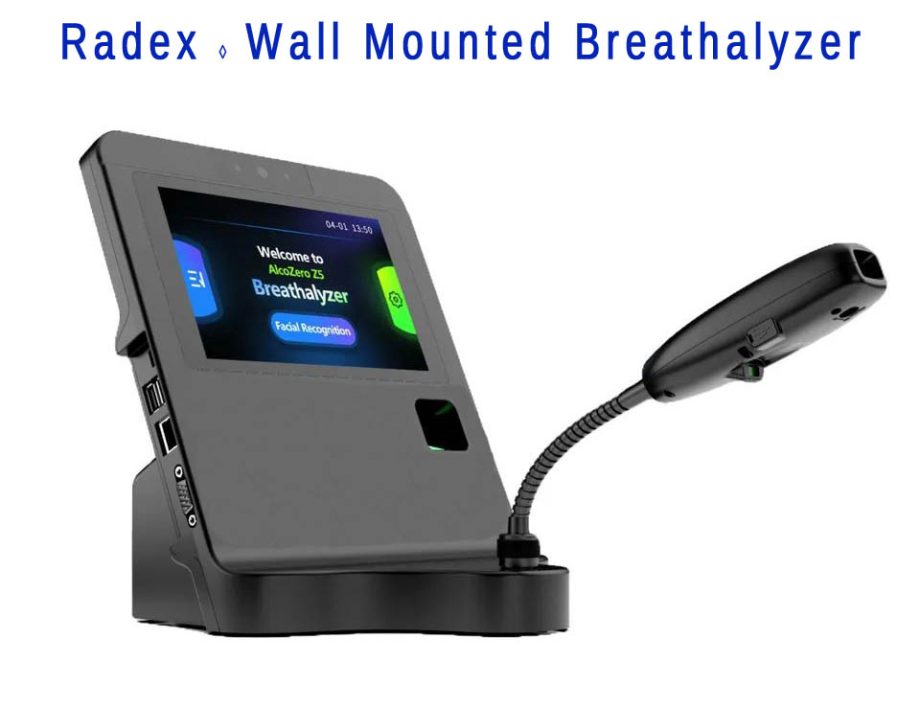-
Alcohol Breath Analyser With Printer
$499.95 -
Baiid Interlock Device
$899.95 -
Radex Alcohol Breath Tester
$89.95 -
Radex Breathalyzer
$69.95
What is an Automobile Breath Tester?
Automobile breathalyzers are widely-used devices that measure the level of alcohol in an individual’s system and help prevent drunk driving accidents. Car breathalyzers, also referred to as ignition interlock devices (IIDs), play an essential part in many states DUI laws. Failing a breath test could result in license suspension and other legal repercussions, with potential license suspension looming overhead if one is failed.
Why use a breathalyzer?
Some breathalyzers are portable devices designed to measure the amount of alcohol present in an individual’s bloodstream. Breathalyzers are often employed by law enforcement officials but may also be found at workplaces, medical clinics, rehabilitation programs, probation offices and halfway houses. Their main function is detecting blood alcohol concentration (BAC) levels in order to alert drivers when they have exceeded legal driving limits.
Breathalyzers work when someone blows into them to set off a chemical reaction that produces an electrical current; this current is then used by the device to calculate one’s blood alcohol concentration level and display it on screen. There are various types of breathalyzers, but most use an electrochemical fuel cell for analysis – alcohol in breath samples is oxidized into protons and electrons which the device measures to determine their BAC level.
Even though breathalyzers can be useful tools, they may produce inaccurate results. This is typically caused by mouth alcohol contamination resulting from using mouthwash or breath fresheners containing alcohol as well as certain medications which contain it.
At times, how the body processes alcohol can alter how quickly it enters their system and affect the results of a breathalyzer test. Therefore, it is advisable to wait at least 15 minutes after drinking or using any mouth products which might alter results before driving – this way your results won’t be negatively impacted.
How does a breathalyzer work?
Breath testing machines measure the alcohol content in your breath rather than directly measuring blood alcohol levels, since alveolar concentration relates directly to bloodstream concentration in approximately 2:100 ratio; test results therefore provide an excellent estimate of your Blood Alcohol Content (BAC).
A breathalyzer works by using a mouthpiece and sensor to measure the level of ethanol in your breath. A special ethanol sensor detects its presence, with results displayed on an electronic screen. Modern breathalyzers may also use an infrared spectrometer which pinpoints molecules by their ability to absorb light before providing a reading of your Blood Alcohol Content (BAC).
Breathalyzers come in various forms, but most devices rely on either a semiconductor oxide or fuel cell sensor. Semiconductor oxide breathalyzers typically use less expensive tin-oxide sensors while platinum fuel cell models cost significantly more; home users and some professional testers commonly opt for these types of breathalyzers for personal or low-volume testing purposes.
Fuel cell breathalyzers employ an electrochemical sensor to detect alcohol in a breath sample, using fuel cells to convert ethanol to electrical currents that are then measured by the device to provide results. Regular calibration and maintenance is recommended to ensure accuracy.
Law enforcement officers carry portable alcohol screeners known as PASs (Portable Alcohol Screening) or EBTs (Elimination Breathalyzers), while larger, more accurate devices found at police stations and jails are known as IIDs (Ignition Interlock Devices), which connect to your car’s ignition system and require you to blow into it before starting it if your BAC exceeds the set limit set by your state. Otherwise, your car won’t start.
Is it legal to use a breathalyzer?
Blood alcohol concentration, or BAC, is an indicator of how drunk an individual is and therefore breath tests are an important tool in law enforcement’s toolbox. New York law mandates that any driver suspected of exceeding the legal driving limit submit to a breath test if law enforcement officer believes they may exceed it; otherwise, refusal of implied consent charges could result in penalties such as DUI/DWI conviction.
Individuals may purchase their own breathalyzers for at-home use, though these devices can be as accurate or may have higher margins of error compared with the more expensive ones used by law enforcement. Furthermore, certain medical conditions can make it more challenging for someone to blow into a breathalyzer; when this is the case it may be in one’s best interests to decline taking part.
According to New York law, anyone failing or refusing to blow into a breath tester will have their license suspended immediately. Furthermore, those convicted of DUI/DWI could face additional sanctions such as jail time and community service obligations.
If you have been charged with DWI due to breathalyzer results, it is critical that you contact an experienced New York criminal attorney as soon as possible. An attorney can review all evidence against you and evaluate possible defenses such as inaccurate machine or noncompliance with instructions for use. Furthermore, an experienced New York lawyer can assist in getting hardship license or other alternatives to full license suspension and advise on your options whether to plead guilty or not guilty.
Can a breathalyzer in a car be tampered with?
Many rumors exist regarding how one might beat a breathalyzer test, including using mouth fresheners, chewing gum, placing one’s finger over the exit port or even sucking on a penny. While such methods may help mask alcohol odor or make it less concentrated in one’s breath sample, they cannot alter your blood alcohol concentration reading from this device.
Some Police use portable breathalyzers with fuel cell sensors that react when exposed to the breath vapor produced by suspects; this produces an electrical charge which is then detected by the sensor; the higher the concentration of ethanol is, the stronger this charge becomes.
These devices must be calibrated regularly in order to maintain accuracy. Failure to do so could result in inaccurate BAC readings and interfere with sensor readings, including items like cigarettes, dental floss, nail polish remover and mouthwash which contain small amounts of alcohol that could skew results during tests. A breathalyzer cannot distinguish between true positives and false positives and it should therefore always remain accurate when testing individuals who appear under suspicion of alcohol consumption.
Another method used by people attempting to circumvent breathalyzers is asking someone else to blow into the device for them, thus rendering the breathalyzers unusable and illegal. Other tampering techniques may include using non breath air to start vehicles and disconnecting devices – all which may result in significant legal repercussions including Ignition Interlock Device (IID) conviction and subsequent jail time, fines and loss of driving privileges.
What happens if I fail a breathalyzer test?
Failing a breath test can have serious repercussions in your life, depending on the laws in your state. You could face being arrested and charged with driving under the influence (DUI). Furthermore, being restricted to vehicles equipped with ignition interlock devices may impede your mobility. In such a situation it is critical that you contact an experienced criminal defense attorney as quickly as possible for legal advice and representation.
Breathalyzer tests may produce inaccurate results for various reasons, including malfunctioning equipment or administration errors. Certain foods and beverages can also trigger false positive results while it takes thirty-ninety minutes for alcohol to fully enter your bloodstream; in addition, people suffering from digestive diseases such as Celiac may cause their stomachs to produce fermentation which causes an artificially high alcohol concentration in their bodies.
Failing a breath test can be distressing and embarrassing. But there are ways you can fight your DUI charges successfully. First, politely decline to submit to any tests on demand as this is against state laws in most places. If you are required to use an IID, but failed the initial test, retaking can be tried after some minutes. Any attempts at tampering with or bypassing it should be reported immediately to both your IID provider and lawyer so as to prevent violations from taking place and possible fines or added time on your obligation for use of IIDs.
Reasons Why Automobile Breath Testers Can Prevent DUI
Many states require drivers with alcohol-related driving convictions to install ignition interlock devices that won’t start their car until they blow clean air into it. These devices prevent drunk driving from starting until an approved breathalyzer test has taken place.
These breathalyzers perform random tests mid-drive, known as rolling retests. Mouthwash, gum or breath mints containing alcohol could trigger false positive results on these devices and could give false readings.
1. Prevents Drowsy Driving
Drowsy driving is one of the leading causes of vehicular crashes and injuries on our roadways, yet it can often be difficult to tell when someone is tired driving. Drivers should be wary of warning signs such as difficulty recalling the last few miles driven or striking rumble strips on the side of the road. Sleepy drivers also may have difficulty reacting quickly to changes in traffic flows.
Sleep is the key to avoiding drowsy driving. Alcohol consumption should also be limited prior to driving as even small amounts can have an adverse impact. Also, avoid driving during peak sleepiness periods (midnight to 6 a.m. and late afternoon). Sleep disorders like obstructive sleep apnea can make getting enough rest difficult.
2. Prevents Drunk Driving
The National Transportation Safety Board is pushing to have technology installed into vehicles that would prevent drivers from exceeding the legal limit and thus increasing safety on roads. Their ultimate aim is to prevent people from driving drunk and potentially endangering others on the road.
Technology such as ignition interlocks may also play a part in this effort, requiring drivers to blow into a tube prior to starting their cars and detect blood alcohol levels before preventing the vehicle from starting up if their breath contains too much alcohol.
But these systems can fail; for example, mouthwash, toothpaste and breath mints may create false positives; according to an investigation by The New York Times reviewing accident reports and lawsuits filed, some individuals attempt to bypass them by having sober friends blow into their tubes instead.
3. Prevents Accidents
People convicted of drunk driving must install an ignition interlock device (IID). These devices require drivers to blow into a tube before starting their car. They also beep periodically as a reminder to take rolling retests while driving – intended as preventive technology against drunk driving but which may actually increase accidents.
According to reports and lawsuits reviewed by The New York Times, IIDs have contributed to multiple accidents caused by distracted driving during rolling retests. Drivers may become distracted while searching for their devices or worrying that they will fail the test and incur penalties.
Problematic road design poses an especially dangerous hazard to drivers as it can trigger chain-reaction crashes that are difficult to prevent. Drivers could become injured or killed as other cars fail to brake in time and collide into them, potentially inflicting serious harm upon themselves or even on those around them.
4. Prevents Injuries
Researchers estimate that widespread installation of alcohol ignition interlock devices (IID or BAIID) on all new cars over 15 years would prevent approximately 85% of alcohol-related motor vehicle deaths and between 84%-88% of nonfatal crashes involving alcohol consumption by drivers, and prevent vehicles from starting when breath alcohol concentration exceeds an established threshold. The device prevents vehicles from starting if an excessive concentration of breath alcohol exists among drivers attempting to start them up.
The device also prompts drivers to perform randomly timed breath tests while driving – these rolling retests may lead to vehicle lock-out or interruption until all rolling retests have been passed successfully.
Drivers can reduce the chances of receiving a false positive by not using mouthwash, toothpaste or breath mints; not eating foods containing sugar; and avoiding carbonated drinks. If the device detects that an attempt has been made to bypass the test by any driver, horns will sound or flashing lights will come on immediately.
5. Prevents Death
While IIDs can be an invaluable asset in the fight against drunk driving, they also present unique risks. One major drawback of IIDs is that drivers must complete a “running test” at random intervals while driving and engage their mind, eyes, and hands in performing this test – which could prove dangerously distracting for any potential drunk drivers.
The New York Times published several accident reports and lawsuits where people crashed their cars while performing tests on IIDs, such as insulin inhalers or intravenous infusion pumps (IIV). This is due to visualizing, fiddling with, and checking messages taking their focus completely away from driving safely – often fatal results! Luckily a breath tester can help prevent such tragedies; most states mandate breath testing before driving again.
